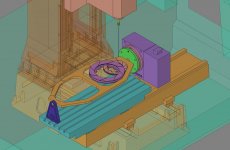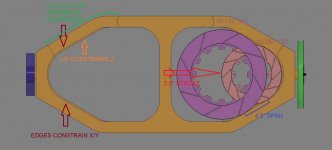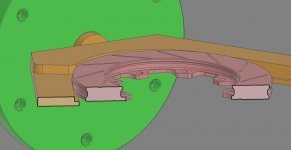This idea was brought up in another thread but I think makes more sense to have its own discussion.
Here's some background on the current process:
These parts are cast iron rotors. They get turned in a few ops on VTLs, then front/back milling on a mag chuck in a VMC, and a perimeter engraving on one of those obnoxious pneumatic machines. In the VMC we load one part right side up and one upside down so every cycle get one finished part.
The front/back surfaces get grooves, the ID flange gets the lobed profile and we add slotted holes. There is no cutting of the OD.
Tolerance on the holes is -0/+.002" otherwise +/-.005". These parts need to be held very flat, the grooves make it very obvious (visually) if a part was milled at any sort of angle. I added a probe routing (thanks to some help from the other discussion!) to verify parts are loaded flat that runs on each part.
We have a range of ODs from 10.787 to 16.142" and thickness from .748 to 1.417".
They get a logo, part and batch number engraved on the perimeter that is maybe 3" long.
We machine specific parts #s in batches of 10-50, these are just based on customer orders so its more or less random how many/what parts are getting made. On an average day we probably switch between 5 different sizes and do 100 total parts.
Someone suggested skipping the mag chuck and loading parts into a rotary fixture and getting two complete parts every cycle. There are a couple other benefits like chip clearance and we could do the engraving so I'd really like to make this work.
I made a rough mock up to verify parts and tools would clear the machine, but now I'm stuck with how we actually would hold the parts. The face grooves go from the ID to OD, the range of diameters is large, and flatness is important.
My first thought was to cut a wide V to constrain X/Y, a narrow lip for Z, and an opposing clamp to lock it all into place. However the lip must be very narrow to avoid the face grooves, and the max stroke for a clamp would be 5.5" so holding parts level seems tricky.
Then I thought about adding toggle/swing clamps to hold it down onto the lip, but because of the 4.5" span of contact along the edges these clamps would need to be adjustable which adds a setup complication...
Maybe we have a drop-in insert specific to a smaller specific range of sizes with its own clamps? Or...?



I've been looking at this for a bit now and feel stuck, another set of eyes might be able to see an obvious solution. I'm hoping some creative people out these can help me figure this out!
Here's some background on the current process:
These parts are cast iron rotors. They get turned in a few ops on VTLs, then front/back milling on a mag chuck in a VMC, and a perimeter engraving on one of those obnoxious pneumatic machines. In the VMC we load one part right side up and one upside down so every cycle get one finished part.
The front/back surfaces get grooves, the ID flange gets the lobed profile and we add slotted holes. There is no cutting of the OD.
Tolerance on the holes is -0/+.002" otherwise +/-.005". These parts need to be held very flat, the grooves make it very obvious (visually) if a part was milled at any sort of angle. I added a probe routing (thanks to some help from the other discussion!) to verify parts are loaded flat that runs on each part.
We have a range of ODs from 10.787 to 16.142" and thickness from .748 to 1.417".
They get a logo, part and batch number engraved on the perimeter that is maybe 3" long.
We machine specific parts #s in batches of 10-50, these are just based on customer orders so its more or less random how many/what parts are getting made. On an average day we probably switch between 5 different sizes and do 100 total parts.
Someone suggested skipping the mag chuck and loading parts into a rotary fixture and getting two complete parts every cycle. There are a couple other benefits like chip clearance and we could do the engraving so I'd really like to make this work.
I made a rough mock up to verify parts and tools would clear the machine, but now I'm stuck with how we actually would hold the parts. The face grooves go from the ID to OD, the range of diameters is large, and flatness is important.
My first thought was to cut a wide V to constrain X/Y, a narrow lip for Z, and an opposing clamp to lock it all into place. However the lip must be very narrow to avoid the face grooves, and the max stroke for a clamp would be 5.5" so holding parts level seems tricky.
Then I thought about adding toggle/swing clamps to hold it down onto the lip, but because of the 4.5" span of contact along the edges these clamps would need to be adjustable which adds a setup complication...
Maybe we have a drop-in insert specific to a smaller specific range of sizes with its own clamps? Or...?



I've been looking at this for a bit now and feel stuck, another set of eyes might be able to see an obvious solution. I'm hoping some creative people out these can help me figure this out!
Last edited:


